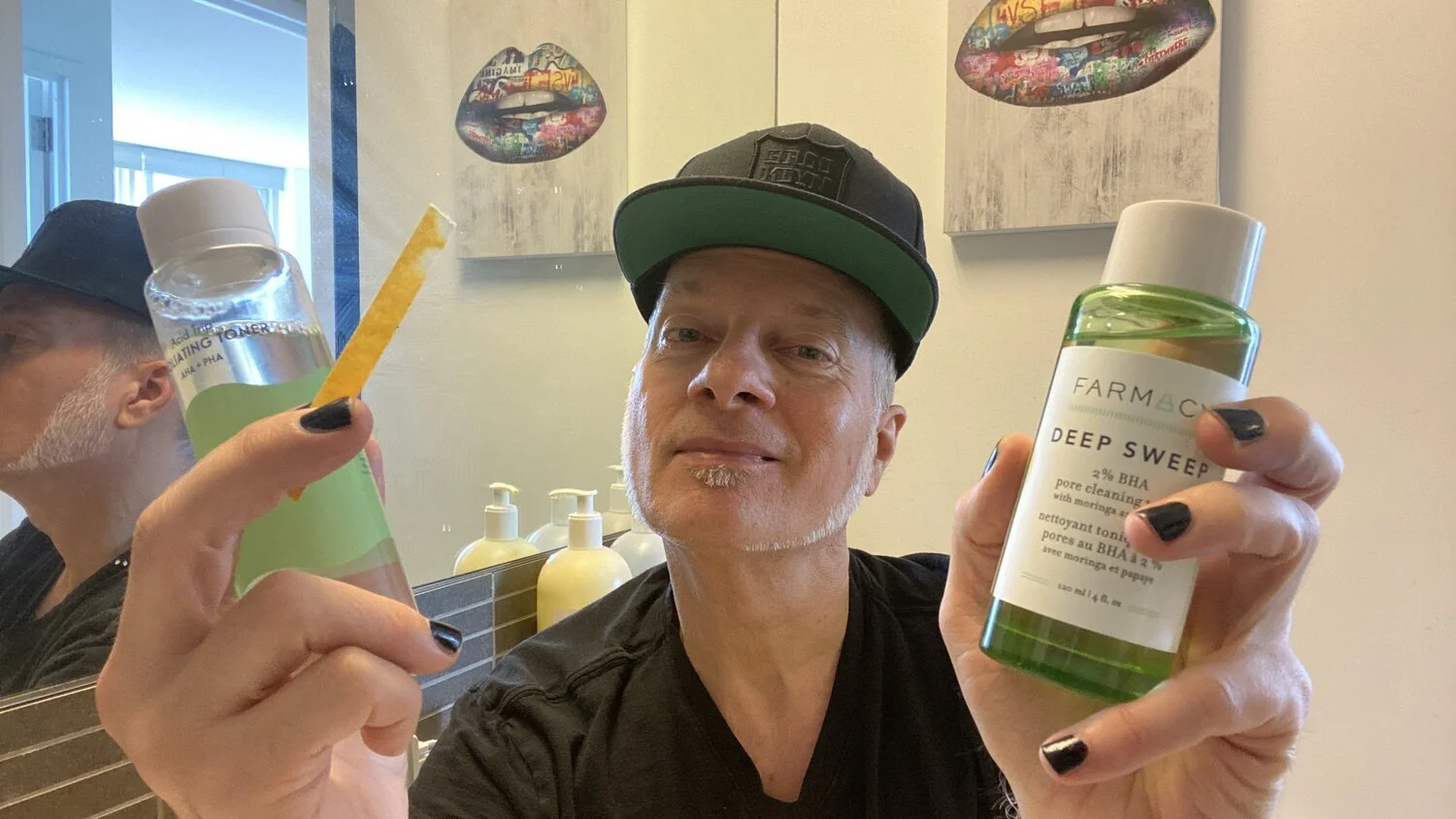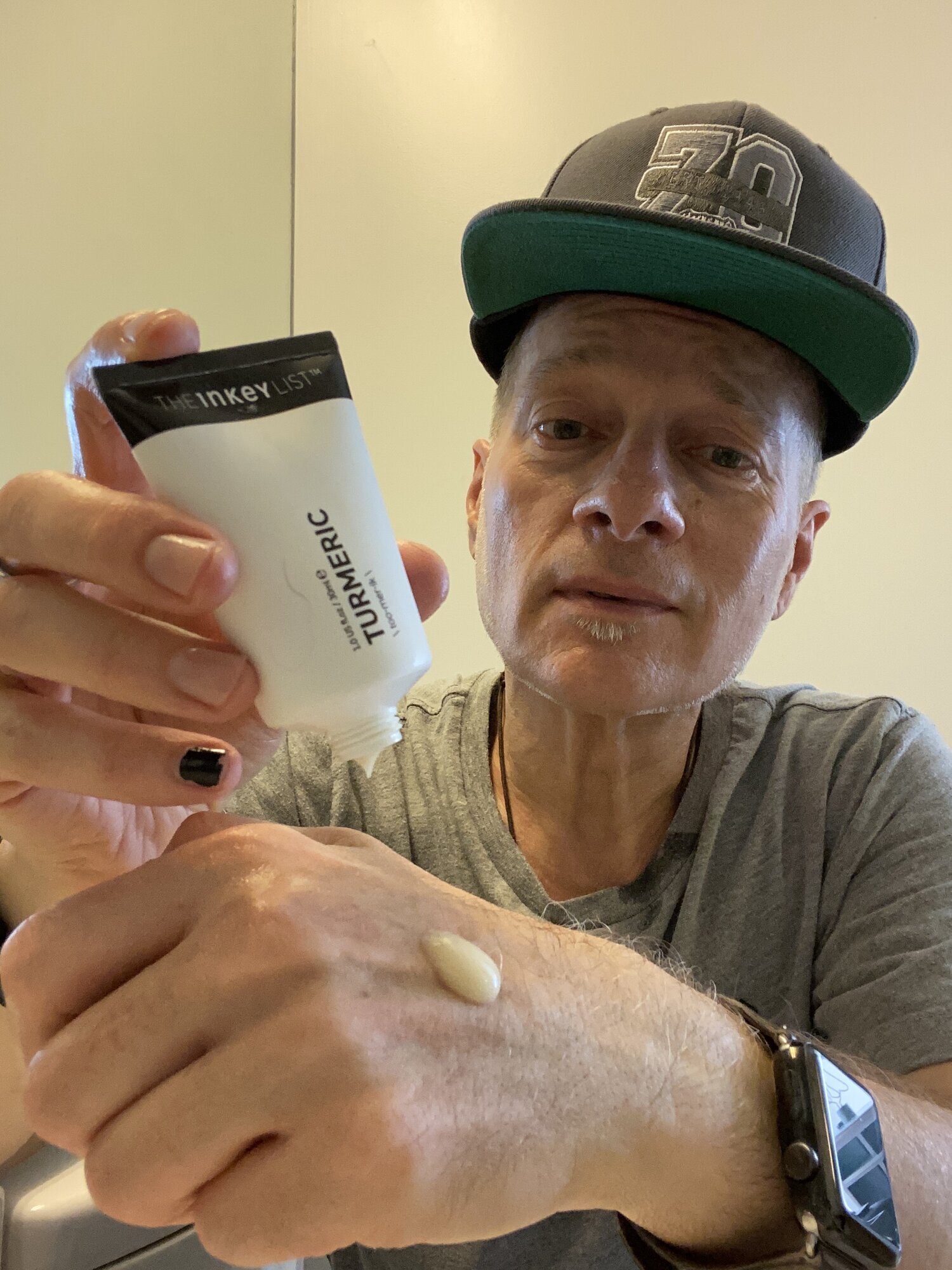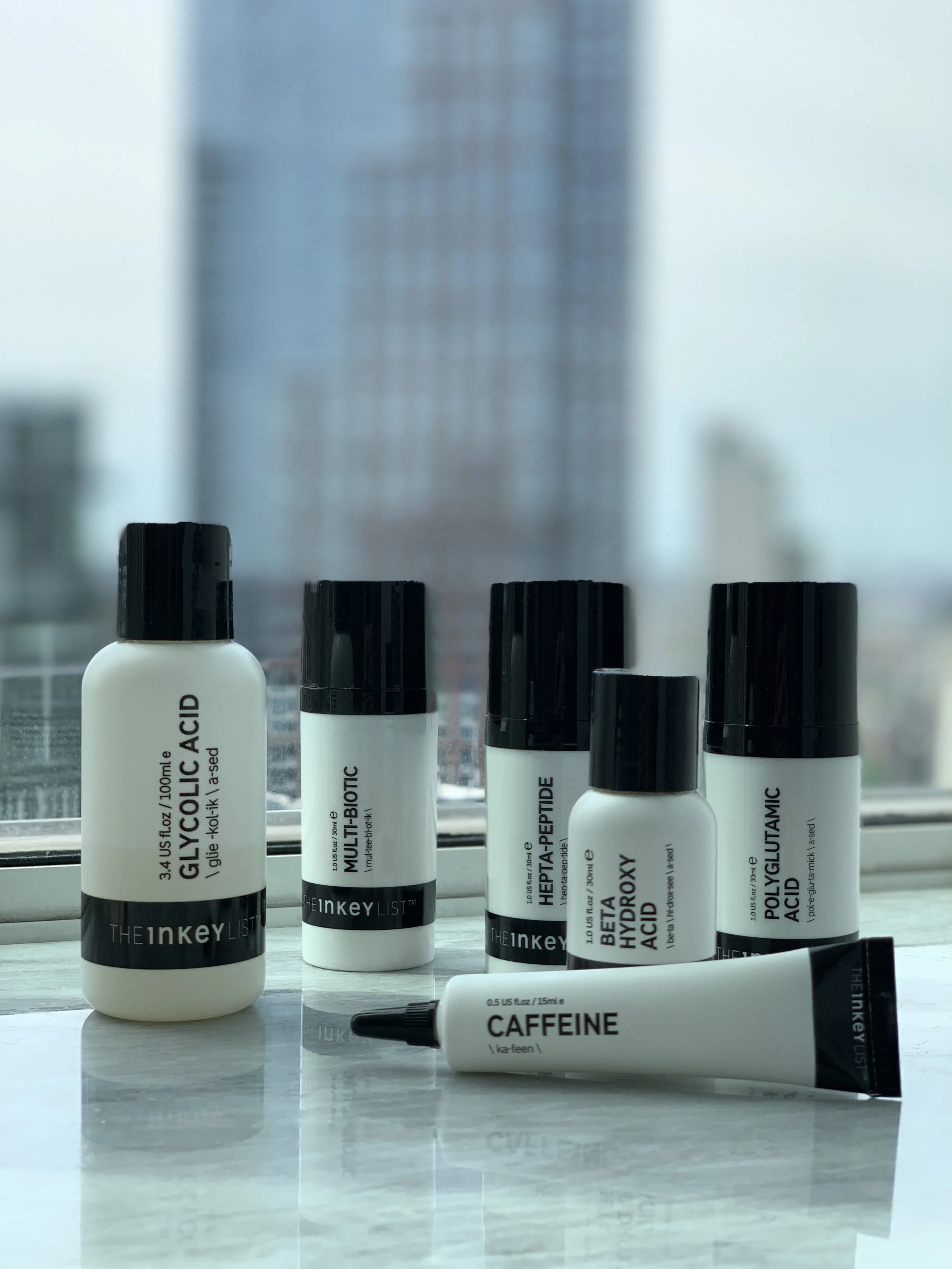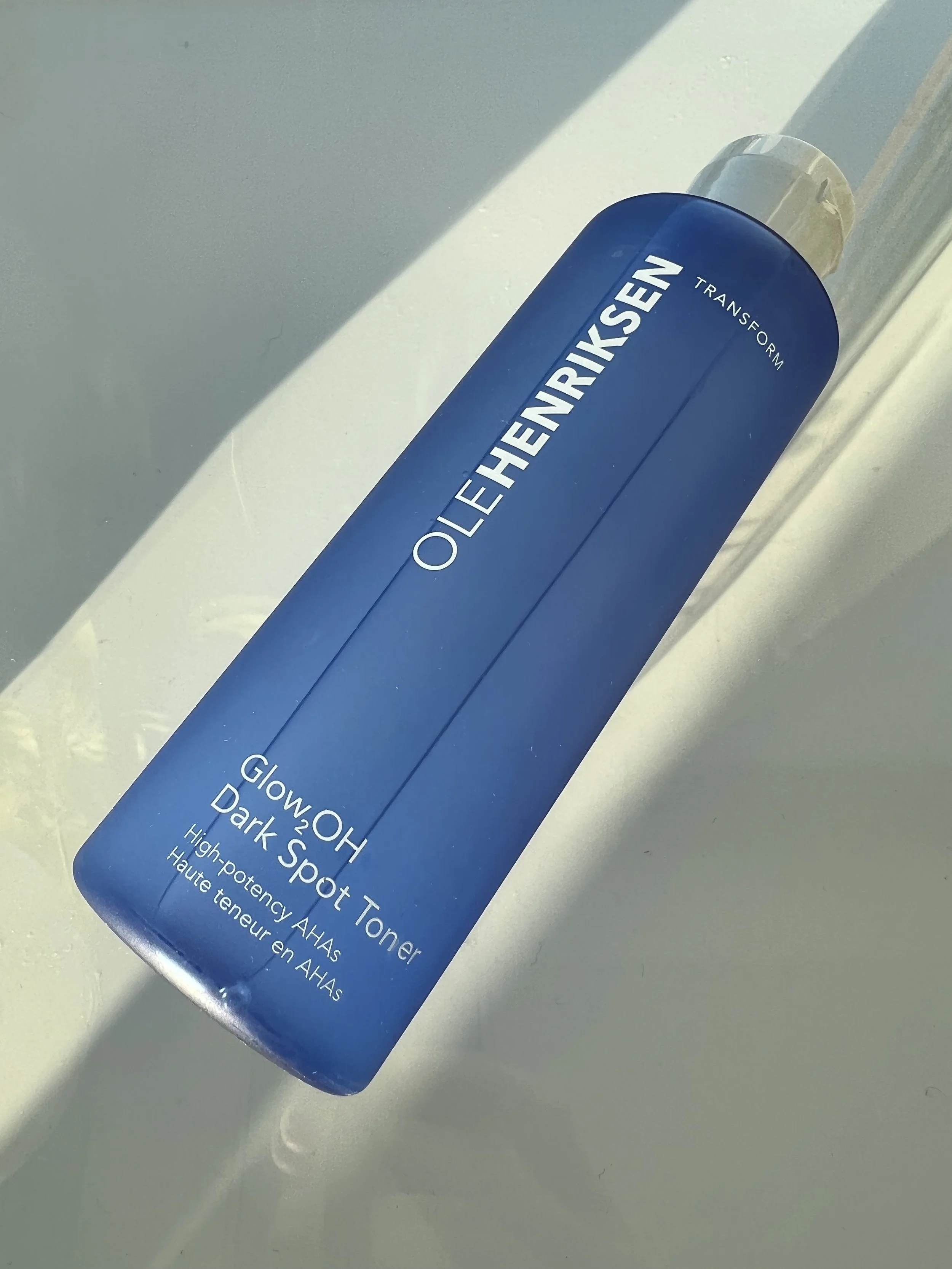PRODUCT REVIEW: THE INKEY LIST POLYHYDROXY ACID (PHA) GENTLE EXFOLIATING TONER – BEST EXFOLIATING TONER, BEST PHA TONER
THE INKEY LIST | PHA TONER
This product review was originally part of my blog article titled, Seasonal Skincare Transitioning: Treatment Toners I Love That Make Me Excited For Cold Weather – Best Exfoliating Toner, Best Toner With Glycolic Acid. You can catch the full piece here.
__
With the change of seasons here in New York City, I make a habit of switching up my skin care. I like to refer to it as “seasonal skincare transitioning.” As the seasons change, so does your skin — and your skin’s everyday needs.
I love switching up my skin care. And I love toners most of all!
The funny thing about toners is not all toners are created equal — or do the same thing. There are two major types of toners: hydrating toners and acid, or treatment toners. The two are not mutually exclusive; that is, you don’t use one or the other. While they’re both called toners, they have completely distinct purposes and benefits for the skin.
Every skincare routine, morning and evening, should consist of a hydrating toner — applied immediately following cleansing. Period. End of story. Hydration is a must, central to a K-beauty routine and IMO essential to a robust and healthy skincare regimen.
PRODUCT REVIEW: INDIE LEE COQ-10 TONER - BEST HYDRATING TONER, BEST ANTIOXIDANT TONER
A treatment toner, on the other hand, is formulated with any number of beneficial exfoliating acids — usually one or more actives from the class of AHA, BHA or PHA hydroxy acids. After employing a hydrating toner, if you want to use a treatment toner to exfoliate and boost skin’s desquamation process, you can.
There are so many things I love about skincare and how skincare products work with the skin. But there’s one entire skincare habit which, while popular, is quite out of control. And that’s exfoliation and the overuse of exfoliating treatments.
Unlike so much of what we do for our skin — including moisturizing, cleansing and protecting from sun damage — the one thing skin does pretty well on its own is what’s termed desquamation.
Every skin cell originating in the lower levels of the skin rises to the surface within 28 days, where it’s freed from the body — like pollen gently floating from wild poppy flowers and disappearing into the air over the horizon.
What Does Desquamation Mean and Why Does Desquamation Occur?
In short, desquamation is the fancy term for cell regeneration, cell death and exfoliation. More specifically, desquamation is the process by which the skin generates new skin cells and 28 days or so later, sheds them. Desquamation essentially encompasses the life cycle of a skin cell.
There’s an excellent, insightful piece on the Very Well Health website titled, Desquamation Process and the Outer Layer of Skin.
According to the health site Very Well Health:
Desquamation is the natural process in which skin cells are created, sloughed away, and replaced. The desquamation process happens in the outermost layer of the skin called the epidermis. The epidermis itself has four unique layers. Each of these layers plays a role in desquamation.
Skin Cells are Born
Sometimes called cell turnover, desquamation happens every second of the day, without you even noticing.
New skin cells are created in the stratum germinativum, which is the deepest layer of the epidermis. This layer is also called the basal layer.
Skin cells begin their life as a single layer of thick, column-shaped cells. These cells are responsible for creating every cell of your skin.
The cells in this layer divide. Half of them stay behind in the stratum germinativum. The other cells begin their migration to the skin's surface.
Cells Reach the Surface, Then Slough Off
The skin cells have reached their final destination — the stratum corneum. Once the cells arrive at this uppermost layer of the skin they are essentially dead.
The cells in the stratum corneum are very flat and tightly packed. These flat, dead cells continuously fall away as newer cells push their way to the surface. In this way, your skin is constantly renewing itself.
Where do all of those dead skin cells go? You might be surprised to know that most of the dust in your home is actually made up of dead skin cells.
The entire desquamation process, from cell birth to sloughing away, takes approximately 14 to 28 days.
Because the desquamation process is so efficient and methodical, I don’t believe skin needs or can generally tolerate daily exfoliation — whether chemical or physical. Even if your skin tolerates it, it doesn’t need it very often. In fact, our skin doesn’t need us to do anything when it comes to exfoliation.
For the record, I don’t use a chemical exfoliant — either a treatment toner or acid-powered serum — more than thrice weekly.
That said, the kind of exfoliation you can achieve with popular, iconic products like the Sunday Riley Good Genes All-In-One Lactic Acid Treatment or my personal fave Paula’s Choice Skin Perfecting 2% Bha Liquid Exfoliant helps to speed up the process of desquamation. Doing so, leaves the complexion free of dead skin. Dead skin cells aren’t doing you any favors.
PRODUCT REVIEW: PAULA’S CHOICE SKIN PERFECTING 2% BHA LIQUID EXFOLIANT – BEST EXFOLIATING TREATMENT
Truth is, dead skin is simply not as reflective as fresh skin, meaning the natural build-up of dead surface skin cells can result in a lackluster complexion — the opposite of the coveted glass skin. Exfoliating treatments brighten the complexion by immediately removing dead skin cells so skin naturally glows. Even healthy skin can appear dull. And who wants that?
Dead surface skin cells also inhibit the penetration of topical skincare, meaning even the Vitamin C serums and best face creams with Retinol cannot be as effective as you want them to be. And the dead skin lingering on your face is the reason. The level of chemical exfoliation you get from a great treatment or acid toner is the perfect solution.
A caveat about physical exfoliation:
As is the case with skin care in general, not all exfoliating products are good for your skin. In fact, physical exfoliators, or face scrubs, can be quite aggressive on the skin and can scratch and otherwise damage the delicate skin barrier.
If you’re using a face scrub, please stop.
Always a terrific resource for skincare tips, education, insights and guidance, the Paula’s Choice website features an excellent article titled, Exfoliation: The Skin Care Step You Never Knew You Needed.
In the piece, the experts on the Paula’s Choice Research Team seek to educate on the differences between chemical and physical exfoliation and the dangers of using a scrub.
“Daily, gentle exfoliation with a leave-on product is a complete game-changer for every skin type and skin concern. Adding this one step to your routine is the fastest, most effective way to get radiant, smooth, hydrated, blemish-free, even-toned skin.
“AHA (alpha hydroxy acid) and BHA (beta hydroxy acid) exfoliants help skin shed dead cells more quickly, the way it did before age and environmental factors began to slow that process. These acids are also the gentlest way to exfoliate, and they nourish and transform the look of your skin in ways no brush or scrub can.
“Despite the popularity of facial scrubs, most are too harsh and abrasive; they can cause tiny tears that damage skin over time, even if that damage isn’t immediately visible. Even the best scrubs, while they do have benefits, can’t produce the same results as an AHA or BHA exfoliant.”
While AHA and BHA-powered chemical exfoliators are the best acid treatments available, they’re not always the most gentle. And sometimes are no more exfoliating than a hydrating toner. The potency and efficacy of an acid toner is dependent on the pH level of the formula and which of the six alpha hydroxy acids are being used; the most potent being Glycolic Acid, the least, Mandelic Acid.
Hot in skincare of late is the newest of the hydroxy acid molecules, Poly Hydroxy Acids, or PHA’s. PHA’s are acids that work more slowly with the skin, meaning they’re more gentle — and more favorable for sensitive skin prone to irritation and redness. If you deal with sensitivity, excessive dryness, eczema or rosacea, a PHA-powered treatment would be your best bet. (Psst…more on PHA’s below!)
With that, let’s take a look at one of my new fave treatment toners, perfect for skincare transitioning as the weather cools down here in NYC…
The Inkey List | Polyhydroxy Acid (PHA) Gentle Exfoliating Toner
I guess you could call me an #inkeyfanboy and get away with it. To be honest, I love just about everything that The Inkey List has ever developed. Since the brand launched more than three years ago, they’ve been an innovation machine.
In that time, I’ve reviewed probably two dozen products from The Inkey List. Among my favorites are The Inkey List’s Turmeric Cream, the Oat Cleansing Balm and the brand’s iconic Caffeine Eye Serum — one of the best eye creams for puffiness.
This past year alone, it seems that The Inkey List doubled their product offerings. At last count, there were 32 Inkey products offered on the Sephora website. And I know that’s not everything the brand offers.
Most of the so-called “democratically priced” skincare brands like The Ordinary, Good Molecules and Naturium stick to simple, single-note formulas like a Vitamin C face cream, Glycolic Acid toner or a Hyaluronic Acid serum.
While The Inkey List certainly offers all of the above, the brand likes to tweak the market with cool, innovative products that aren’t going to be bestsellers. Rather, they’re fun and make the brand more interesting beyond its basic black and white packaging.
The Inkey List’s Apple Cider Vinegar Acid Peel is the perfect example. What could be more intriguing and niche than that? Oh, how about a Snow Mushroom Moisturizer? Yup, Inkey has that too!
BRANDS I LOVE: THE INKEY LIST AFFORDABLE SKINCARE - BEST ANTI-AGING SERUMS, BEST ANTI-AGING MOISTURIZERS
It’s hard to believe that The Inkey List offers products that I have never tried. Until recently, I actually hadn’t had the chance to experience The Inkey List’s Polyhydroxy Acid (PHA) Gentle Exfoliating Toner or just PHA Toner for short.
As with many of The Inkey List’s products, the PHA Toner is a relatively simple formulation. With a tight, 16-ingredient-deep INCI, it’s not difficult to ascertain exactly what the product does and who it’s intended for.
As with Maysama’s ABP11+ Green Rooibos Gentle Resurfacing Toner, the PHA Toner from The Inkey List is powered by a solid dose of the most gentle of the hydroxy acids, the PHA Gluconolactone. With a 3% concentration of Gluconolactone, the formula is relatively tame in terms of its exfoliating potency. And unlike the Maysama version, it doesn’t contain any additional exfoliating acids like Lactic or Salicylic.
Beyond that 3% concentration of PHA Gluconolactone, there’s 3% Niacinamide, my favorite antioxidant. Even a three-percent level of Niacinamide twice a day can be beneficial for the skin. It’s not enough on its own though. In my humble opinion, you can’t get enough Niacinamide into your skin each day.
There are, of course, multiple ways to get Niacinamide into your skincare routine — and into your skin. You can go the straight up, cut-to-the-chase route with a dedicated serum like my all-time favorite, the Paula’s Choice 10% Niacinamide Booster. Or, you can get it in smaller doses a little at a time as is the case with The Inkey List Polyhydroxy Acid (PHA) Gentle Exfoliating Toner.
What Is Niacinamide and What Does Niacinamide Do for the Skin?
I found a comprehensive article on Niacinamide written by the skin experts on the Paula’s Choice Research Team, titled simply, How Niacinamide Helps Skin. Here’s an excerpt:
How Niacinamide Helps Skin
Niacinamide is a skin care ingredient worthy of your attention and your skin will love you for using it. Among a handful of other amazing skin care ingredients such as retinol and vitamin C, niacinamide is a standout because of its versatility for almost any skin care concern and skin type.
As many of you know about us, but for those who don’t, the conclusions we make about any ingredient are always based on what the published research has shown to be true—and the research about niacinamide unanimously demonstrates how special it is. New research keeps showing it’s one of the most exciting skin care ingredients around.
What is Niacinamide?
Also known as vitamin B3 and nicotinamide, niacinamide is a water-soluble vitamin that works with the natural substances in your skin to help visibly minimize enlarged pores, tighten lax pores, improve uneven skin tone, soften fine lines and wrinkles, diminish dullness, and strengthen a weakened surface.
Niacinamide also reduces the impact of environmental damage because of its ability to improve skin’s barrier (its first line of defense), plus it also plays a role in helping skin to repair signs of past damage. Left unchecked, this type of daily assault makes skin appear older, dull, and less radiant.
Why You Should Use Niacinamide
As you might have gathered, we’re very impressed with all that niacinamide can do for skin when applied via skin care products like toners, serums, and highly concentrated leave-on treatments. Niacinamide is uniquely compatible with any of the products in your skin care routine, including those that contain retinol, peptides, hyaluronic acid, AHAs, BHA, vitamin C, and all types of antioxidants.
You can use multiple niacinamide-containing products in your routine, and it will still be non-sensitizing as this ingenious B vitamin is well tolerated by all skin types. It’s even suitable for use by those with sensitive or rosacea-prone skin.
Other helpful benefits of niacinamide are that it helps renew and restore the surface of skin against moisture loss and dehydration by helping skin improve its natural production of skin-strengthening ceramides. When ceramides become depleted over time, skin is left vulnerable to all sorts of problems, from persistent patches of dry, flaky skin to increasingly becoming extra-sensitive.
If you struggle with dry skin, topical application of niacinamide has been shown to boost the hydrating ability of moisturizers so skin’s surface can better resist the moisture loss that leads to recurrent dry, tight, flaky skin. Niacinamide works brilliantly with common moisturizer ingredients like glycerin, non-fragrant plant oils, cholesterol, sodium PCA, and sodium hyaluronate.
How does niacinamide help pores? Great question, although the answer here isn’t certain. Simply put, research hasn’t come to a full understanding about how this B vitamin works its pore-reducing magic, but it does! It seems that niacinamide has a normalizing ability on the pore lining, and that this influence plays a role in keeping debris from getting backed up, which leads to clogs and rough, bumpy skin. As the clog forms and worsens, the pores stretch to compensate, and what you’ll see is enlarged pores. By helping things get back to normal, niacinamide use helps pores return to their normal size. Sun damage can cause pores to become stretched, too, leading to what some describe as "orange peel skin". Higher concentrations of niacinamide can help visibly tighten pores by shoring up skin’s supportive elements.
NIACINAMIDE IS THE GAME CHANGER YOU NEED TO DEFEND AGAINST SKIN DAMAGE AND MAINTAIN OPTIMAL SKIN HEALTH
What I like about it: Even though The Inkey List’s PHA Exfoliating Toner is a simple formula, it has a lot of pro-skin health goodness. It gently exfoliates, brightens, soothes — and all that for just about $10. It’s excellent for amping up your routine twice a day.
What I don’t like about it: The low level of the gentlest of the exfoliating acids, PHA Gluconolactone, means this treatment toner will fall short of expectations if you’re looking for more intense exfoliation. That’s said, it’s great for sensitive skin or beginners to chemical exfoliation.
Who it’s for: All skin types, especially sensitive skins.
SHOP THE BLOG: Purchase The Inkey List Polyhydroxy Acid (PHA) Gentle Exfoliating Toner for $10.99 here.
WATCH MY VIDEO REVIEW
I’M GETTING #SELFCARESUNDAY LIT! 🔥 POWERING UP MY BRIGHTENING WITH MAYSAMA BEAUTY!
ON MY YOUTUBE CHANNEL HERE
WATCH MY VIDEO REVIEW OF
SKINCARE HACKS: GLYCOLIC ACID IS THE NATURAL DEODORANT THAT WORKS!
ON MY YOUTUBE CHANNEL HERE
WATCH MY VIDEO REVIEW
COOL CLEAN FACIAL SUNSCREENS TO KEEP US SAFE AND SMILING IN THE SUN!
ON MY YOUTUBE CHANNEL HERE
WATCH MY VIDEO REVIEW
THE YEAR’S BEST VITAMIN C SERUMS WITH PAULA'S CHOICE, SUNDAY RILEY, THE INKEY LIST AND MORE!
ON MY YOUTUBE CHANNEL HERE
WATCH MY VIDEO REVIEW
THE BEST HYALURONIC ACID SERUMS FROM PAULA'S CHOICE, THE INKEY LIST, GHOST DEMOCRACY & MORE
ON MY YOUTUBE CHANNEL HERE
WATCH MY VIDEO REVIEW OF
A SELFCARE SUNDAY NOT FOR THE FAINT OF HEART – WITH THE PAULA’S CHOICE 25% AHA PEEL!
ON MY YOUTUBE CHANNEL HERE
WATCH MY VIDEO REVIEW
MY 2021 VITAMIN C PICKS + THE BEST VITAMIN C SERUMS TO BRIGHTEN UP THE COMPLEXION!
ON MY YOUTUBE CHANNEL HERE
The Ingredient List of the Farmacy Deep Sweep 2% BHA Pore Cleaning Toner with Moringa + Papaya:
 so|h, Aqua solv, Niacinamide (3%)
so|h, Aqua solv, Niacinamide (3%)  cci|sb|aacne|h, Glycerin
cci|sb|aacne|h, Glycerin  sii|h 0 0, Aspalathus Linearis (Green Rooibos) Leaf Extract (1.3%), Citric Acid buff, Lysolecithin emu, Sclerotium Gum vc, Cannabis Sativa (Hemp) Seed Oil emo, Sodium Benzoate pres, Pullulan, Xanthan Gum vc|emu|surf, Centella Asiatica Leaf Extract, Sodium Hyaluronate
sii|h 0 0, Aspalathus Linearis (Green Rooibos) Leaf Extract (1.3%), Citric Acid buff, Lysolecithin emu, Sclerotium Gum vc, Cannabis Sativa (Hemp) Seed Oil emo, Sodium Benzoate pres, Pullulan, Xanthan Gum vc|emu|surf, Centella Asiatica Leaf Extract, Sodium Hyaluronate  sii|h 0 0, Adansonia Digitata (Baobab) Seed Oil
sii|h 0 0, Adansonia Digitata (Baobab) Seed Oil  emo, Potassium Sorbate pres, Tocopherol
emo, Potassium Sorbate pres, Tocopherol  aox 0-3 0-3, Argania Spinosa (Argan) Kernel Oil
aox 0-3 0-3, Argania Spinosa (Argan) Kernel Oil  aox|emo, Sodium Phytate chel, Ubiquinone
aox|emo, Sodium Phytate chel, Ubiquinone  aox, Glycine Soja Oil
aox, Glycine Soja Oil  emo|perf 0 3, Silica vc, Hydroxypropyl Cyclodextrin
emo|perf 0 3, Silica vc, Hydroxypropyl Cyclodextrin  , Hippophae Rhamnoides (Sea Buckthorn) Fruit Extract, Curcuma Longa (Turmeric) Root Extract
, Hippophae Rhamnoides (Sea Buckthorn) Fruit Extract, Curcuma Longa (Turmeric) Root Extract  aox|so|sb|perf, Chlorella Vulgaris Powder, Tetrahydropiperine, Glycyrrhiza Glabra (Liquorice) Root Extract
aox|so|sb|perf, Chlorella Vulgaris Powder, Tetrahydropiperine, Glycyrrhiza Glabra (Liquorice) Root Extract  so|sb, Calendula Officinalis (Marigold) Flower Extract
so|sb, Calendula Officinalis (Marigold) Flower Extract  so|aox|perf, Palmitoyl Tripeptide-38
so|aox|perf, Palmitoyl Tripeptide-38  cci
cciThe Ingredient List of the Good Molecules Glycolic Exfoliating Toner:
 exf|buff, Propanediol solv|h, Sodium Citrate chel|buff, 1,2-Hexanediol solv, Glycerin
exf|buff, Propanediol solv|h, Sodium Citrate chel|buff, 1,2-Hexanediol solv, Glycerin  sii|h 0 0, Galactomyces Ferment Filtrate
sii|h 0 0, Galactomyces Ferment Filtrate  h, Butylene Glycol h|solv|vc 0 1, Salicylic Acid
h, Butylene Glycol h|solv|vc 0 1, Salicylic Acid  exf|aacne|so|pres, Aloe Barbadensis Leaf Extract
exf|aacne|so|pres, Aloe Barbadensis Leaf Extract  so|emo|h, Pentylene Glycol solv|h, Niacinamide
so|emo|h, Pentylene Glycol solv|h, Niacinamide  cci|sb|aacne|h, Tricholoma Matsutake Extract, Ethylhexylglycerin pres, Hydrolyzed Cicer Seed Extract, Rhododendron Chrysanthum Leaf Extract so, Trisodium Ethylenediamine Disuccinate chel, Sodium Hyaluronate
cci|sb|aacne|h, Tricholoma Matsutake Extract, Ethylhexylglycerin pres, Hydrolyzed Cicer Seed Extract, Rhododendron Chrysanthum Leaf Extract so, Trisodium Ethylenediamine Disuccinate chel, Sodium Hyaluronate  sii|h 0 0, Hyaluronic Acid
sii|h 0 0, Hyaluronic Acid  sii|h, Hydrolyzed Hyaluronic Acid
sii|h, Hydrolyzed Hyaluronic Acid  h
hThe Ingredient List of the Maysama ABP11+ Green Rooibos Gentle Resurfacing Toner:
Aqua (Water), Aloe Barbadensis Leaf Juice, Gluconolactone, Lactic Acid, Glycerin, Sodium Hydroxide, Ascorbic Acid, Salicylic Acid, Aspalathus Linearis Leaf Extract, Saccharomyces/ Xylinum /Black Tea Ferment, Camellia Sinensis Leaf Extract, Undaria Pinnatifidia Leaf/Stem Extract, Sodium Polyacrylate, Ascorbyl Glucoside, Sodium Phytate, Citric Acid, Sorbic Acid, Sodium Benzoate, Benzyl Alcohol, Potassium Sorbate.
The Ingredient List of The Inkey List PHA Toner:
 exf|chel, Niacinamide
exf|chel, Niacinamide  cci|sb|aacne|h, Pentylene Glycol solv|h, Glycerin
cci|sb|aacne|h, Pentylene Glycol solv|h, Glycerin  sii|h 0 0, Aloe Barbadensis Leaf Juice
sii|h 0 0, Aloe Barbadensis Leaf Juice  so|h, Potassium Sorbate pres, Sodium Benzoate pres, PPG-26-Buteth-26, PEG-40 Hydrogenated Castor Oil emu|surf, 1,2-Hexanediol solv, Caprylyl Glycol h|emo, Ethylhexylglycerin pres, Citric Acid buff, Sodium Hydroxide buff
so|h, Potassium Sorbate pres, Sodium Benzoate pres, PPG-26-Buteth-26, PEG-40 Hydrogenated Castor Oil emu|surf, 1,2-Hexanediol solv, Caprylyl Glycol h|emo, Ethylhexylglycerin pres, Citric Acid buff, Sodium Hydroxide buffThe Ingredient List of the Youth To The People Mandelic Acid + Superfood Unity Exfoliant:
 exf|amic, Ethoxydiglycol solv|h|perf 0 0, Salicylic Acid
exf|amic, Ethoxydiglycol solv|h|perf 0 0, Salicylic Acid  exf|aacne|so|pres, Rosa Damascena (Rose) Flower Water, Gluconolactone
exf|aacne|so|pres, Rosa Damascena (Rose) Flower Water, Gluconolactone  exf|chel, Leuconostoc/Radish Root Ferment Lysate Filtrate, Aloe Barbadensis (Aloe Vera) Leaf Juice Powder
exf|chel, Leuconostoc/Radish Root Ferment Lysate Filtrate, Aloe Barbadensis (Aloe Vera) Leaf Juice Powder  so|h, Brassica Oleracea Acephala (Kale) Leaf Extract h, Camellia Sinensis (Green Tea) Leaf Extract
so|h, Brassica Oleracea Acephala (Kale) Leaf Extract h, Camellia Sinensis (Green Tea) Leaf Extract  aox|so, Chamomilla Recutita (Matricaria) Flower Extract
aox|so, Chamomilla Recutita (Matricaria) Flower Extract  so|aox 0 0, Medicago Sativa (Alfalfa) Leaf Extract, Spinacia Oleracea (Spinach) Leaf Extract, Glycyrrhiza Glabra (Licorice) Root Extract
so|aox 0 0, Medicago Sativa (Alfalfa) Leaf Extract, Spinacia Oleracea (Spinach) Leaf Extract, Glycyrrhiza Glabra (Licorice) Root Extract  so|sb, Moringa Oleifera Leaf Extract, Moringa Oleifera Seed Extract, Glucosamine Hcl, Panthenol
so|sb, Moringa Oleifera Leaf Extract, Moringa Oleifera Seed Extract, Glucosamine Hcl, Panthenol  so|h 0 0, Glycerin
so|h 0 0, Glycerin  sii|h 0 0, Arginine
sii|h 0 0, Arginine  sii, Sodium Phytate chel, Sodium Hydroxide buff, Sodium Ascorbyl Phosphate
sii, Sodium Phytate chel, Sodium Hydroxide buff, Sodium Ascorbyl Phosphate  aox|aacne, Maltodextrin, Citric Acid buff, Potassium Sorbate pres, Phenoxyethanol pres, Sodium Benzoate pres
aox|aacne, Maltodextrin, Citric Acid buff, Potassium Sorbate pres, Phenoxyethanol pres, Sodium Benzoate pres



























